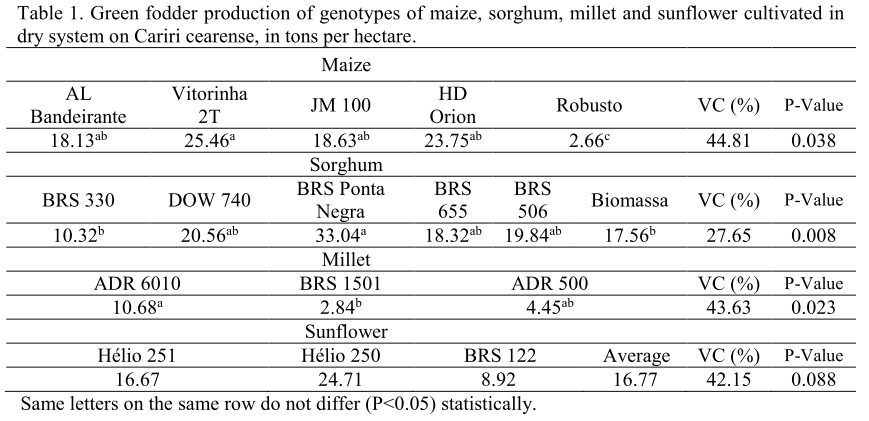
Avaliação da produção de massa de forragem verde de genótipos de milho, sorgo, milheto e girassol cultivados em condições não irrigadas na região do Cariri Cearense.
2 - Professor do ensino básico, técnico e tecnologico do IFCE campus Crato
3 - Pesquisador Embrapa Caprinos e Ovinos
4 - Professor do ensino básico, técnico e tecnologico do IFCE campus Crato
5 - Professor do ensino básico, técnico e tecnologico do IFCE campus Crateús
6 - Professor do ensino básico, técnico e tecnologico do IFCE campus Crato
7 - Estudante de Zootecnia, IFCE campus Crato
8 - Estudante de Zootecnia, IFCE campus Crato
RESUMO -
O presente estudo objetivou mensurar a produção de massa de forragem verde de genótipos de milho, sorgo, milheto e girassol em condições não irrigadas na região do Cariri Cearense. Para a cultura de milho foram avaliados cinco genótipos: Vitorinha 2T, Robusto, HD Orion, AL Bandeirante e JM 100. Para o sorgo foram seis genótipos: Dow 740, Sorgo Biomassa, BRS 506, BRS 655, BRS 330 e o BRS Ponta Negra. Já para o girassol e milheto foram avaliados três genótipos: Hélio 250, Hélio 251, BRS 122 e ADR 6010, BRS 1501, ADR 500, respectivamente. Os tratos culturais foram os recomendados para cada cultura, sendo utilizado sistema de sequeiro. Foram coletadas variáveis biométricas relacionadas a produção de massa de forragem verde. No milho, a produção de massa de forragem verde (MV) variou de 2,66 t MV/ha a 25,46 t MV/ha. Houve grande variação na produtividade de MV nos diferentes genótipos de milho, sorgo, milheto e girassol avaliados.
Evaluation of green fodder production of maize, sorghum, millet and sunflower genotypes grown under non-irrigate conditions in the Cariri Cearense region.
ABSTRACT - This study objected measure the green fodder production of genotypes of maize, sorghum, millet and sunflower in non-irrigate conditions in the Cariri Cearense region. For maize were evaluated five genotypes: Vitorinha 2T, Robusto, HD Orion, AL Bandeirante and JM 100. For sorghum were six genotypes: Dow 740, Sorgo Biomassa, BRS 506, BRS 655, BRS 330 and BRS Ponta Negra. To the sunflower and millet were evaluated three genotypes: Hélio 250, Hélio 251, BRS 122 and ADR 6010, BRS 1501, ADR 500, respectively. Cultural dealings were recommended for each culture, being used dry system. Were collected biometrical variables related to green fodder production. In the maize, the green fodder (GF) production ranged from 2.66 t GF/ha to 25. 46 t GF/ha. There was great variation in MV productivity in the different maize, sorghum, millet and sunflower genotypes evaluated.Introdução
Semi-arid regions, predominantly in Brazilian northeast, constantly suffer with periods of bad weather due prolonged droughts characterized by high temperatures, low humidity, high evaporation rates, low rainfall and irregularities in its distribution. Thus, the choice of culture to be cultivated depends mainly on species adaptability to adverse conditions and productivity. The productivity is an important feature to be considered in the culture selection for ensilage because, besides the nutritional value, seeks greater production per unit area. This study objected measure the green fodder production of genotypes of maize, sorghum, millet and sunflower in non-irrigate conditions in the Cariri Cearense region.Revisão Bibliográfica
The animal production it is directly related to vegetable production. The creation of ruminants in Brazil is predominantly made to the grass and with the production of conserved voluminous to animal feed in drought season. However, the tropical climate decreases the vegetable production compared to temperate regions. Thereafter, the animal production faces obstacles in the tropics regarding food availability (VAN SOEST, 1994). Several cultivars and hybrids of various cultures are developed and available to the producers aiming the greater productivity and productive efficiency. The genotypes are developed to express their potential in specific conditions of fertility, water conditions and other development factors. Therefore, it is observed that the productivity of cultivars and hybrids in Brazil is below expected due the environmental conditions do not meet the requirements to maximum yield. Tardin et al. (2011) states that to achieve greater productivity in crops, the producers must choose adapted cultivars to their regions and to their production systems, in addition to planning for deployment and leading the crop.Materiais e Métodos
The experiment was developed at the Federal Institute of Science, Education and Technology of Ceará (IFCE), campus Crato, in the county of Crato, Ceará. The geographical location it is 7º12’25” South latitude, 39º26’48” West longitude and 271 m of altitude above sea level. The average annual precipitation is 1086 mm and the relative humidity is 87%. The climate classification is Aw according to Köppen. The experiment was implanted in a 2.000 m² area, with soil classified as clay-textured Hidromorphic Vertisol (EMBRAPA, 1999). The physicochemical characteristics of the soil were determined by collection of three soil samples from the area that were sent to the Laboratory of Soil and Water Sciences of the Federal University of Ceara. The experimental area was plowed and harrowed, then, based on the soil chemical analysis, corrective was applied (limestone or plaster) according to pH value. After the corrective application, one more harrowing was made to incorporate the correctives to the soil. Then, the grooves were made for plaiting, by a furrow linked to tractor, obeying a distance of 1.8 m between them. For maize were evaluated five genotypes: Vitorinha 2T, Robusto, HD Orion, AL Bandeirante and JM 100. For sorghum were six genotypes: Dow 740, Sorgo Biomassa, BRS 506, BRS 655, BRS 330 and BRS Ponta Negra. To the sunflower and millet were evaluated three genotypes: Hélio 250, Hélio 251, BRS 122 and ADR 6010, BRS 1501, ADR 500, respectively. Cultural dealings were recommended for each culture, being used dry system. Were collected biometrical variables related to green fodder production. The experimental lineation was randomized blocks with four repetitions and plots of two rows of four meters and spacing 0,85 meters between rows. The statistics analysis were made by System of Statistical and Genetical Analysis – SAEG (UFV, 2001).Resultados e Discussão
The Table 1 shows data related to production in tons per hectare of green fodder of the different genotypes of maize, sorghum, millet and sunflower. In the maize, the green fodder production (GF) ranged from 2.66 t GF/ha to 25. 46 t GF/ha. The highest GF production in t/ha was observed in cultivar Vitorinha 2T (25.46), not statistically differing (P<0.05) from HD Orion, JM 100 and AL Bandeirante genotypes, with 23.75, 16.63 and 18.13 t GF/ha, respectively. Ferrari Júnior et al. (2005), comparing eight maize cultivars, obtained higher yield to maize AL Bandeirante, with 46.44 t GF/ha. The Robusto variety obtained smaller yield (2.66). The average value of GF production was 17.73 t/ha, below registered by Beleze et al. (2003), evaluating maize hybrids, 44.98 t GF/ha and by Santos et al. (2010), 33.08 t GF/ha, where he evaluated the productivity of six maize varieties. Among the sorghum cultivars, the BRS Ponta Negra variety had a 33.04 t GF/ha productivity, over the Biomassa (17.56) and BRS 330 (10.32) varieties (P<0.05). Santos et al. (2007) highlight the potential of that variety as competitor in relation to other evaluated varieties, obtaining yield which ranged from 16.1 to 55.26 t GF/ha. There was no significant difference between sorghum BRS Ponta Negra and the varieties DOW 740 (20.56), BRS 506 (19.84), BRS 655 (18.32) which did not statistic differ from the Biomassa and BRS 330 varieties. The average yield of the evaluated sorghum cultivars was 19.94 t GF/ha. About the millet culture, the ADR 6010 variety had greater yield, with 10.46 t GF/ha differing from BRS 1501 variety, with 2.84 t GF/ha (P<0.05). There was no significant difference between the genotype ADR 500 (4.45) and the cultivars ADR 6010 and BRS 1501. These results differ from those found by Pires et al. (2007), where he evaluated de agronomic performance of millet varieties and for the variety ADR 500 obtained productivity of 60 t GF/ha. According Bonamingo (1993), depending on the culture conditions, the millet can produce 20 to 70 t/ha of green fodder. The sunflower genotypes, Hélio 251, Hélio 250 and BRS 122 had productivity of 16.67, 24.71 and 8.92 t GF/ha, respectively, with average yield of 16.77 t GF/ha.Conclusões
There was great variation in MV productivity in the different maize, sorghum, millet and sunflower genotypes evaluated. For maize and sorghum, the cultivars Vitorinha 2T and BRS Ponta Negra stood out from the others, respectively. In order to choose the genotype to be used, it is necessary to evaluate the conditions of production and which is better adapted, so that the maximum yield is expressed.Gráficos e Tabelas



